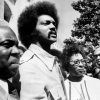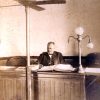calsfoundation@cals.org
Labor Day Bombings of 1959
The Labor Day bombings in Little Rock (Pulaski County) in 1959 represented the last gasp of opposition to the desegregation of the capital city’s Central High School. Coming almost two years to the day after the Little Rock Nine’s first attempt to attend Central High, the coordinated set of explosions evinced a stark and violent reminder of the continuing racial tensions in Arkansas’s capital. The damage was limited, however, and the effort was arguably more symbolic than substantive. At the same time, the bombings highlighted the fact that, while the determined effort to resist the integration of Central High had finally been overcome—with the historic high school having opened its doors for the 1959–60 school year to a student body that included both blacks and whites—the change had not yet been universally accepted.
After Central High was closed for the 1958–59 so-called Lost Year, the situation in Little Rock was still fragile, and the Labor Day bombings rocked the city. Aimed at a distinctive set of targets, the explosions damaged the school board offices, the front of the building that housed the mayor’s office, and a city-owned car that was parked in Fire Chief Gann Nalley’s driveway. The subsequent investigation into the bombing revealed that there was initially a fourth target, the office of Letcher Langford, a member of the city manager board. However, police believed that the effort to explode the bomb at Langford’s office was abandoned due to the high volume of traffic on the widely traveled road that ran between the Arkansas State Capitol and the city’s business district.
The bombs were clearly intended to send a message, and the city was shocked and angered. Thirty-one directors and former presidents of the Little Rock Chamber of Commerce met and issued a statement deploring the bombings, declaring that they did irreparable damage to the city’s reputation. They also posted a $25,000 reward to facilitate the search for the bombers.
The Committee for the Peaceful Operation of Free Public Schools condemned the bombings as cowardly acts of terrorism. Attorney General Bruce Bennett initially blamed the Communist Party for the bombings, and that concern may explain why Federal Bureau of Investigation (FBI) lab experts were quickly sent in to help in the investigation. Most importantly, local law enforcement officials responded quickly to the blast. Their investigation determined that the bombing had been planned at a Ku Klux Klan meeting only a few days before. Some early reports indicated that a cache of sixty-five sticks of dynamite as well as fuses had been discovered behind a local house, and police originally said that as many as fifty suspects might be arrested. However, within seventy-two hours of the bombings, the five individuals actually involved had been arrested and charged.
Police identified forty-eight-year-old local businessman E. A. Lauderdale as the originator and ringleader of the bombing plot. A member of the board of directors for the segregationist organization the Capital Citizens’ Council and the owner of a Little Rock roofing and building materials company, Lauderdale had twice run unsuccessfully for the city’s governing board. In addition to Lauderdale, Little Rock police also arrested and charged J. D. Sims, age thirty-five, a local truck driver; Jesse Raymond Perry, twenty-four, also a truck driver; John Taylor Coggins, thirty-nine, a used-car salesman; and Samuel Graydon Beavers, forty-nine, a carpenter employed by the state. A bond of $50,000 was set for all, but initially only Lauderdale was able to meet his. The preliminary hearings for the five defendants were held on the following Monday, a week after the bombings. The FBI also determined that right-wing minister Billy James Hargis met with the bombing suspects at a restaurant in Memphis, Tennessee, but were unable to charge him due to lack of evidence of his involvement.
Prosecutors, led by Prosecuting Attorney J. Frank Holt, quickly brought the defendants to trial. Sims immediately pleaded guilty and began serving his prison term less than two weeks after the bombings. He then served as the state’s major witness against Perry, but they shared the same story, asserting that they had been hired as a part of a “confidential squad” formed to attack the city to protest its acceptance of the desegregation orders.
Coggins was convicted on November 4 by a jury that included one black member. Coggins, testifying in his own defense, admitted to planting a bomb consisting of ten sticks of dynamite in front of Mayor Werner C. Knoop’s construction company’s office. However, he defended his action, asserting that he believed that the package, which he testified had been given to him by Lauderdale, was, in fact, little more than a smoke bomb and that he was only intending to mirror the prank that had been carried out earlier in the summer at another of the city’s high schools. Coggins recalled that when he heard it go off, he felt that he had been tricked into doing something wrong. He was found guilty, and Beavers’s trial and guilty verdict quickly followed. In the end, Coggins, Sims, Perry, and Beavers were all sentenced to prison terms ranging from three to five years and fined $500.
The trial proceedings concluded on November 28, 1959, with Lauderdale convicted by an all-white jury, sentenced to three years in prison, and assessed a $500 fine. However, the plot’s organizer appealed his conviction, basing his appeal on the fact that, due to pre-trial publicity, there should have been a change of venue; he also asserted his right as a defendant to interrogate prospective jurors.
The Arkansas Supreme Court upheld the verdicts, dispatching the venue and jury issues in a decision handed down in February 1961. Only then did Lauderdale begin to serve his sentence. However, his time in prison was short. Governor Orval Faubus—who had decried the original acts of violence while also telling the state’s citizens that he saw the violence as another effect of the federal government’s efforts to force desegregation of Central High—reduced Lauderdale’s sentence to one year, making him eligible for parole after he had served only six months of the sentence. Faubus also commuted the sentences of Perry, Coggins, and Beavers, all of whom served less than six months. Ironically, Sims, who pleaded guilty at the outset and then cooperated as a prosecution witness, spent the longest time in prison, ultimately serving just under two years.
The 1959 Labor Day bombings represented the last major resistance to the desegregation of Little Rock’s schools. Racial tensions remained, but the city’s leaders accepted the federal dictate, sought to move ahead, and turned their energies to repairing the damage done to the city’s reputation during the tumultuous period.
For additional information:
“ARKANSAS: Bomber’s Fate.” Time, December 7, 1959, p. 24.
Bentley, George. “Jury Suggests 3 Year Term For Lauderdale.” Arkansas Gazette, November 18, 1959, pp. 1A, 2A.
“Convict Third Little Rock Bomb Suspect.” Chicago Daily Tribune, November 5, 1959, p. 26. Online at http://archives.chicagotribune.com/1959/11/05/page/26/article/convict-third-little-rock-bomb-suspect (accessed October 15, 2020).
Cope, Graeme. “‘The Master Conspirator’ and His Henchmen: The KKK and the Labor Day Bombings of 1959.” Arkansas Historical Quarterly 76 (Spring 2017): 49–67.
“Dynamiters’ Cache Found at Little Rock.” Chicago Daily Tribune, September 12, 1959, p. 10. Online at http://archives.chicagotribune.com/1959/09/12/page/10/article/dynamiters-cache-found-at-little-rock (accessed October 15, 2020).
Lauderdale v. State, 343 S.W. 2d 422 (1961). http://law.justia.com/cases/arkansas/supreme-court/1961/4985-0.html (accessed October 15, 2020).
Murphy, Sarah Alderman. Breaking the Silence: The Little Rock Women’s Emergency Committee to Open Our Schools, 1958–1963. Fayetteville: University of Arkansas Press, 1997.
William H. Pruden III
Ravenscroft School








Comments
No comments on this entry yet.